International Business Report: UK SME Expansion in China (21496486)
VerifiedAdded on 2022/01/13
|18
|6264
|148
Report
AI Summary
This report analyzes the international business operations of a UK-based SME, specifically focusing on its potential expansion into the Chinese market, with a focus on the UHT milk sector. The report begins with an executive summary and an introduction that highlights market trends and the drivers behind company expansion in China. A PESTEL analysis is conducted to assess the political, economic, social, technological, environmental, and legal factors influencing the business environment. The report then explores relevant trade theories and identifies potential trade barriers, including tariffs, regulations, subsidies, and exchange rate controls, that the SME might encounter. Ethical and social issues, particularly corporate social responsibility (CSR), are examined in the context of doing business in China. Furthermore, cultural preferences are discussed, emphasizing the importance of cultural awareness. Finally, the report evaluates various internationalization methods, such as export-based and equity-based methods, to determine the most appropriate strategies for the UK SME's expansion. The report concludes with a strategic evaluation framework and references, providing a comprehensive overview of the challenges and opportunities associated with international business in the Chinese market.
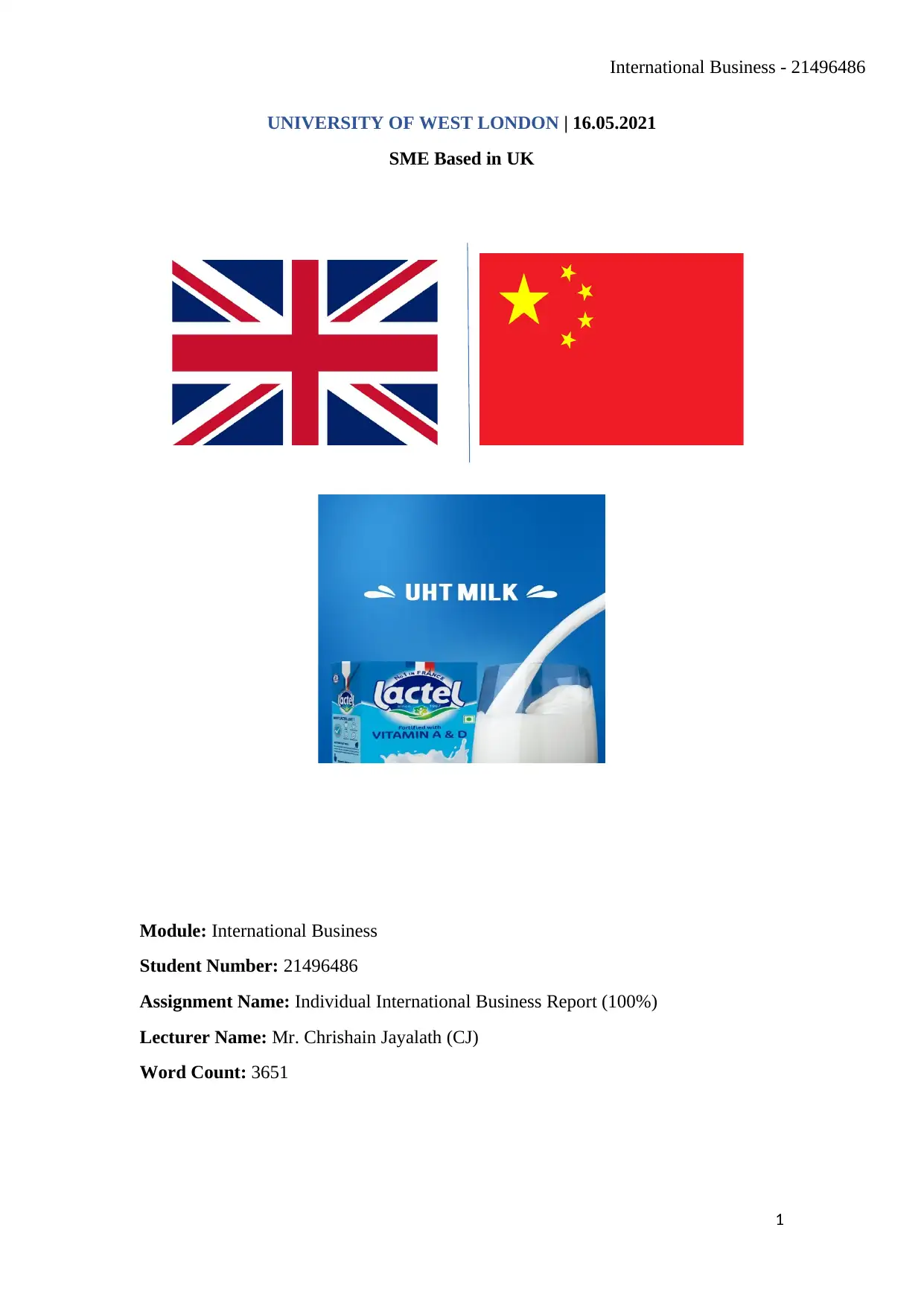
International Business - 21496486
UNIVERSITY OF WEST LONDON | 16.05.2021
SME Based in UK
Module: International Business
Student Number: 21496486
Assignment Name: Individual International Business Report (100%)
Lecturer Name: Mr. Chrishain Jayalath (CJ)
Word Count: 3651
1
UNIVERSITY OF WEST LONDON | 16.05.2021
SME Based in UK
Module: International Business
Student Number: 21496486
Assignment Name: Individual International Business Report (100%)
Lecturer Name: Mr. Chrishain Jayalath (CJ)
Word Count: 3651
1
Paraphrase This Document
Need a fresh take? Get an instant paraphrase of this document with our AI Paraphraser
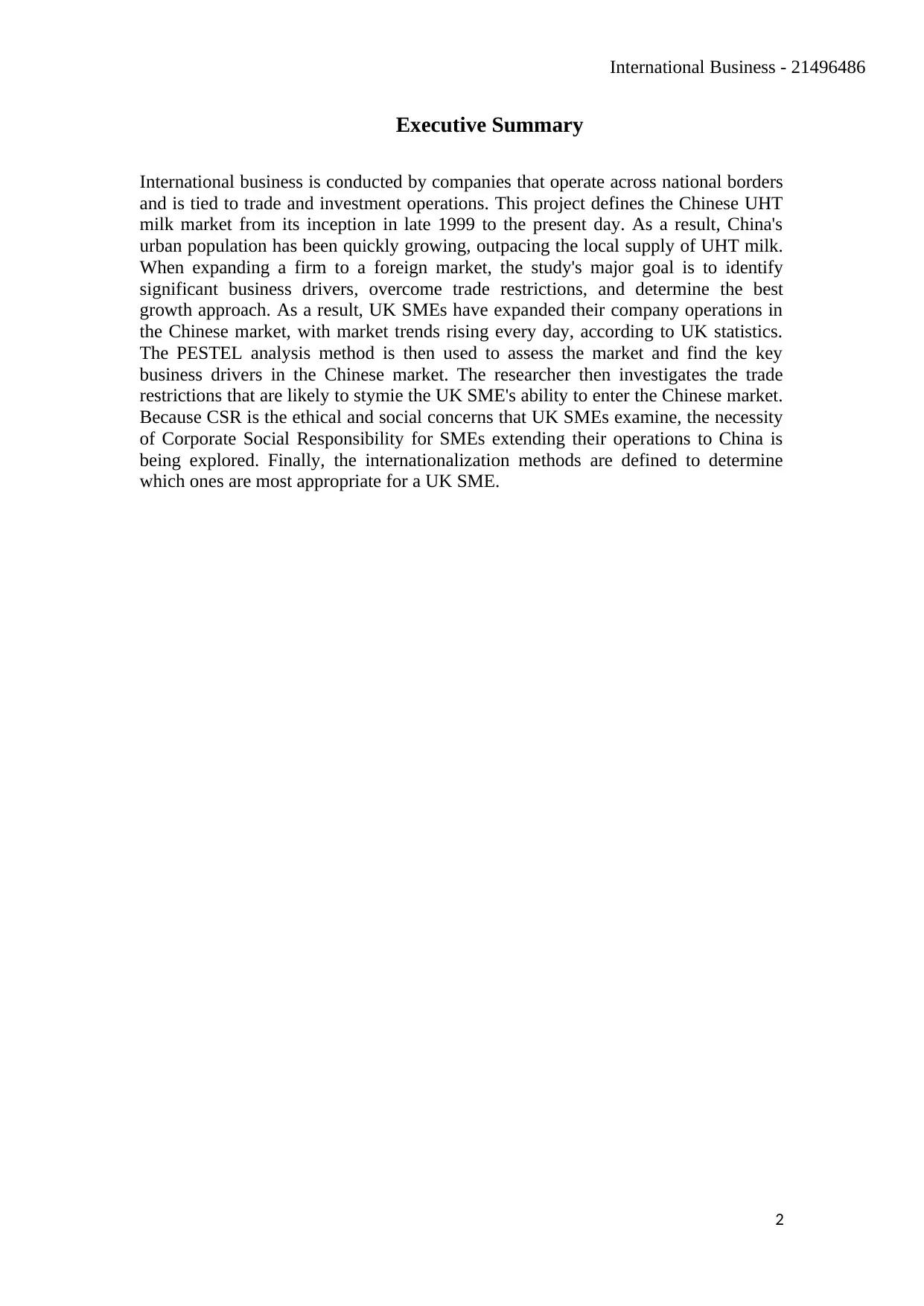
International Business - 21496486
Executive Summary
International business is conducted by companies that operate across national borders
and is tied to trade and investment operations. This project defines the Chinese UHT
milk market from its inception in late 1999 to the present day. As a result, China's
urban population has been quickly growing, outpacing the local supply of UHT milk.
When expanding a firm to a foreign market, the study's major goal is to identify
significant business drivers, overcome trade restrictions, and determine the best
growth approach. As a result, UK SMEs have expanded their company operations in
the Chinese market, with market trends rising every day, according to UK statistics.
The PESTEL analysis method is then used to assess the market and find the key
business drivers in the Chinese market. The researcher then investigates the trade
restrictions that are likely to stymie the UK SME's ability to enter the Chinese market.
Because CSR is the ethical and social concerns that UK SMEs examine, the necessity
of Corporate Social Responsibility for SMEs extending their operations to China is
being explored. Finally, the internationalization methods are defined to determine
which ones are most appropriate for a UK SME.
2
Executive Summary
International business is conducted by companies that operate across national borders
and is tied to trade and investment operations. This project defines the Chinese UHT
milk market from its inception in late 1999 to the present day. As a result, China's
urban population has been quickly growing, outpacing the local supply of UHT milk.
When expanding a firm to a foreign market, the study's major goal is to identify
significant business drivers, overcome trade restrictions, and determine the best
growth approach. As a result, UK SMEs have expanded their company operations in
the Chinese market, with market trends rising every day, according to UK statistics.
The PESTEL analysis method is then used to assess the market and find the key
business drivers in the Chinese market. The researcher then investigates the trade
restrictions that are likely to stymie the UK SME's ability to enter the Chinese market.
Because CSR is the ethical and social concerns that UK SMEs examine, the necessity
of Corporate Social Responsibility for SMEs extending their operations to China is
being explored. Finally, the internationalization methods are defined to determine
which ones are most appropriate for a UK SME.
2
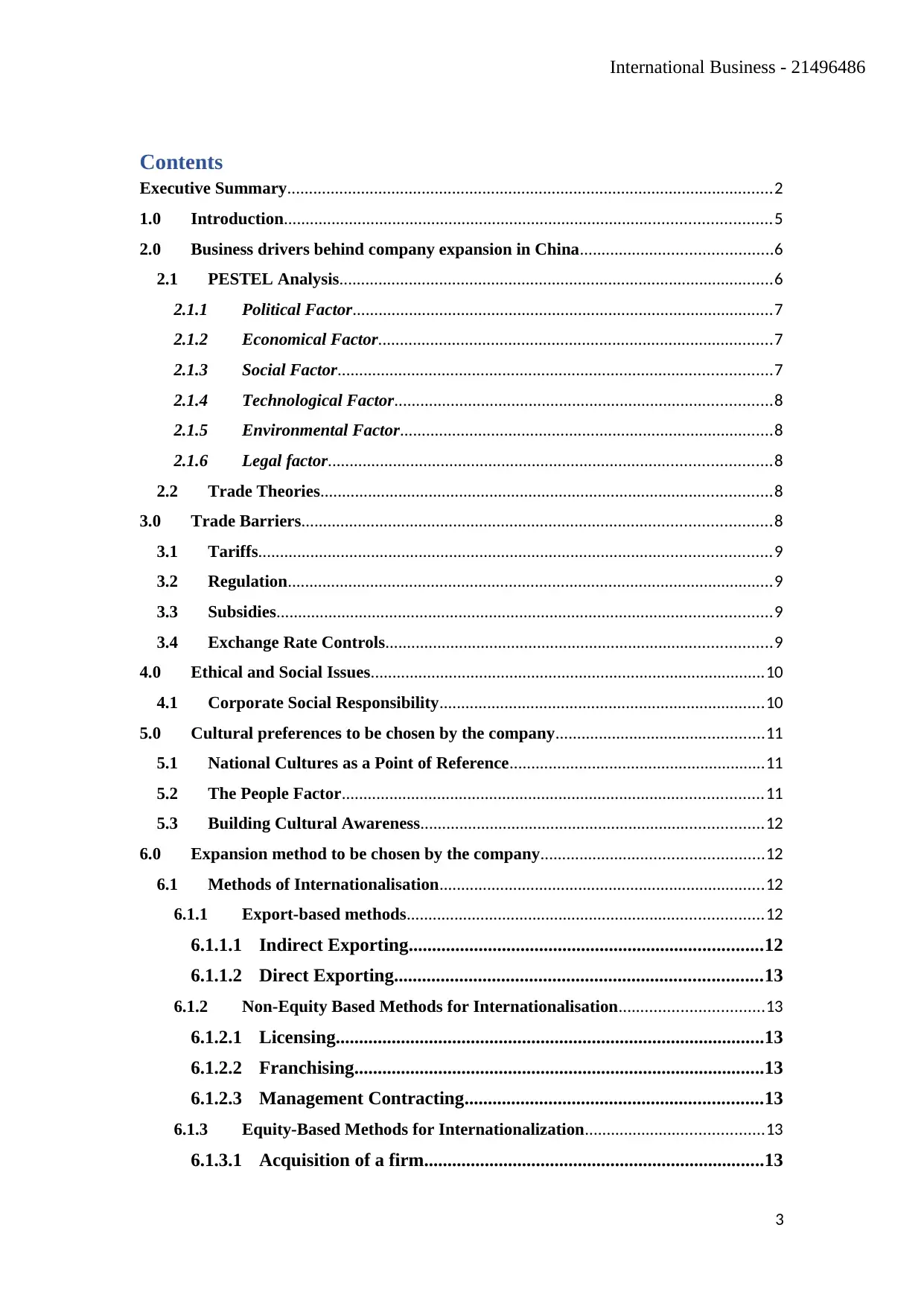
International Business - 21496486
Contents
Executive Summary................................................................................................................2
1.0 Introduction................................................................................................................5
2.0 Business drivers behind company expansion in China............................................6
2.1 PESTEL Analysis....................................................................................................6
2.1.1 Political Factor.................................................................................................7
2.1.2 Economical Factor...........................................................................................7
2.1.3 Social Factor....................................................................................................7
2.1.4 Technological Factor.......................................................................................8
2.1.5 Environmental Factor......................................................................................8
2.1.6 Legal factor......................................................................................................8
2.2 Trade Theories........................................................................................................8
3.0 Trade Barriers............................................................................................................8
3.1 Tariffs......................................................................................................................9
3.2 Regulation................................................................................................................9
3.3 Subsidies..................................................................................................................9
3.4 Exchange Rate Controls.........................................................................................9
4.0 Ethical and Social Issues...........................................................................................10
4.1 Corporate Social Responsibility...........................................................................10
5.0 Cultural preferences to be chosen by the company................................................11
5.1 National Cultures as a Point of Reference...........................................................11
5.2 The People Factor.................................................................................................11
5.3 Building Cultural Awareness...............................................................................12
6.0 Expansion method to be chosen by the company...................................................12
6.1 Methods of Internationalisation...........................................................................12
6.1.1 Export-based methods..................................................................................12
6.1.1.1 Indirect Exporting............................................................................12
6.1.1.2 Direct Exporting...............................................................................13
6.1.2 Non-Equity Based Methods for Internationalisation.................................13
6.1.2.1 Licensing............................................................................................13
6.1.2.2 Franchising........................................................................................13
6.1.2.3 Management Contracting................................................................13
6.1.3 Equity-Based Methods for Internationalization.........................................13
6.1.3.1 Acquisition of a firm.........................................................................13
3
Contents
Executive Summary................................................................................................................2
1.0 Introduction................................................................................................................5
2.0 Business drivers behind company expansion in China............................................6
2.1 PESTEL Analysis....................................................................................................6
2.1.1 Political Factor.................................................................................................7
2.1.2 Economical Factor...........................................................................................7
2.1.3 Social Factor....................................................................................................7
2.1.4 Technological Factor.......................................................................................8
2.1.5 Environmental Factor......................................................................................8
2.1.6 Legal factor......................................................................................................8
2.2 Trade Theories........................................................................................................8
3.0 Trade Barriers............................................................................................................8
3.1 Tariffs......................................................................................................................9
3.2 Regulation................................................................................................................9
3.3 Subsidies..................................................................................................................9
3.4 Exchange Rate Controls.........................................................................................9
4.0 Ethical and Social Issues...........................................................................................10
4.1 Corporate Social Responsibility...........................................................................10
5.0 Cultural preferences to be chosen by the company................................................11
5.1 National Cultures as a Point of Reference...........................................................11
5.2 The People Factor.................................................................................................11
5.3 Building Cultural Awareness...............................................................................12
6.0 Expansion method to be chosen by the company...................................................12
6.1 Methods of Internationalisation...........................................................................12
6.1.1 Export-based methods..................................................................................12
6.1.1.1 Indirect Exporting............................................................................12
6.1.1.2 Direct Exporting...............................................................................13
6.1.2 Non-Equity Based Methods for Internationalisation.................................13
6.1.2.1 Licensing............................................................................................13
6.1.2.2 Franchising........................................................................................13
6.1.2.3 Management Contracting................................................................13
6.1.3 Equity-Based Methods for Internationalization.........................................13
6.1.3.1 Acquisition of a firm.........................................................................13
3
⊘ This is a preview!⊘
Do you want full access?
Subscribe today to unlock all pages.

Trusted by 1+ million students worldwide
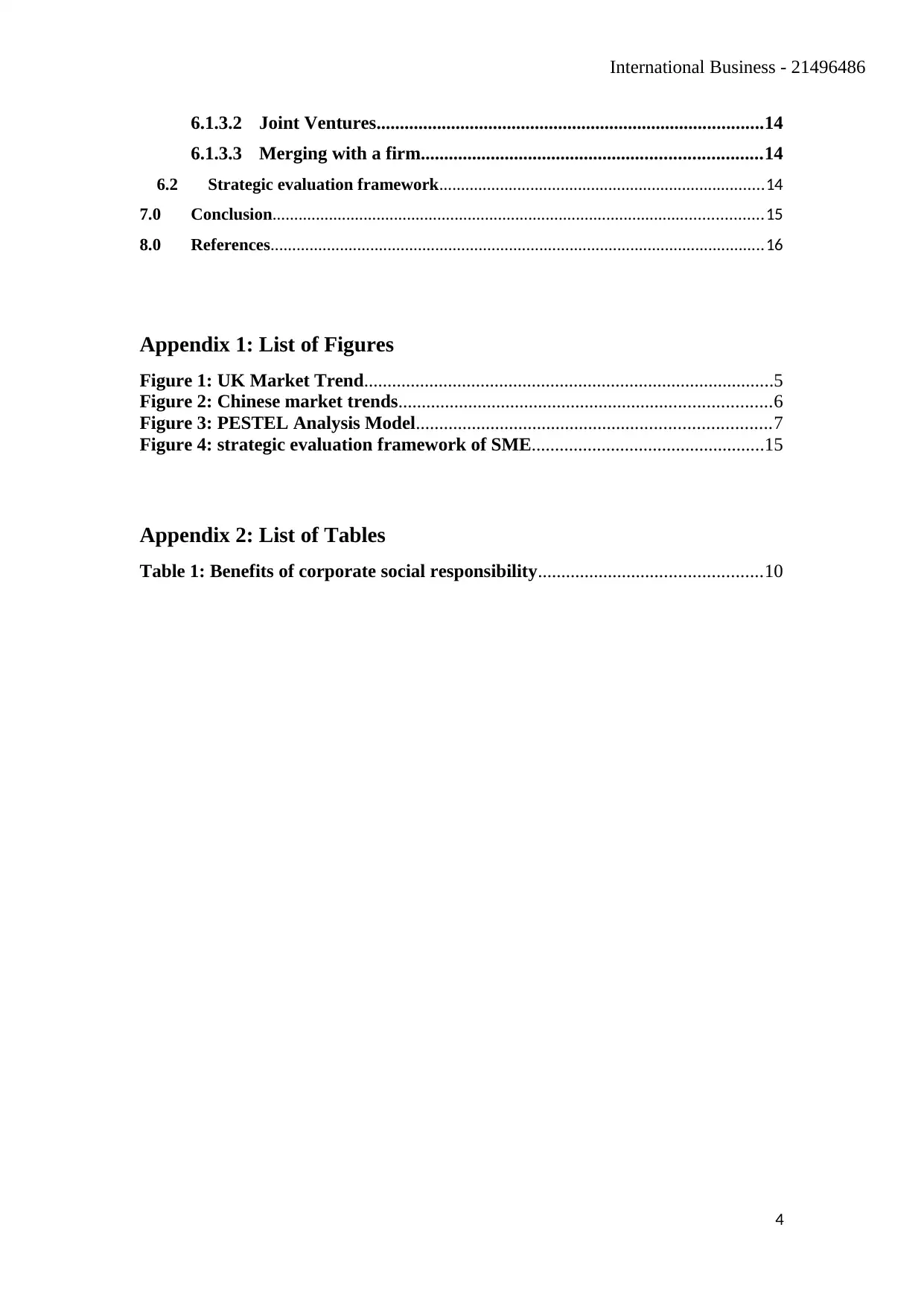
International Business - 21496486
6.1.3.2 Joint Ventures...................................................................................14
6.1.3.3 Merging with a firm.........................................................................14
6.2 Strategic evaluation framework...........................................................................14
7.0 Conclusion.................................................................................................................15
8.0 References..................................................................................................................16
Appendix 1: List of Figures
Figure 1: UK Market Trend........................................................................................5
Figure 2: Chinese market trends................................................................................6
Figure 3: PESTEL Analysis Model............................................................................7
Figure 4: strategic evaluation framework of SME..................................................15
Appendix 2: List of Tables
Table 1: Benefits of corporate social responsibility................................................10
4
6.1.3.2 Joint Ventures...................................................................................14
6.1.3.3 Merging with a firm.........................................................................14
6.2 Strategic evaluation framework...........................................................................14
7.0 Conclusion.................................................................................................................15
8.0 References..................................................................................................................16
Appendix 1: List of Figures
Figure 1: UK Market Trend........................................................................................5
Figure 2: Chinese market trends................................................................................6
Figure 3: PESTEL Analysis Model............................................................................7
Figure 4: strategic evaluation framework of SME..................................................15
Appendix 2: List of Tables
Table 1: Benefits of corporate social responsibility................................................10
4
Paraphrase This Document
Need a fresh take? Get an instant paraphrase of this document with our AI Paraphraser
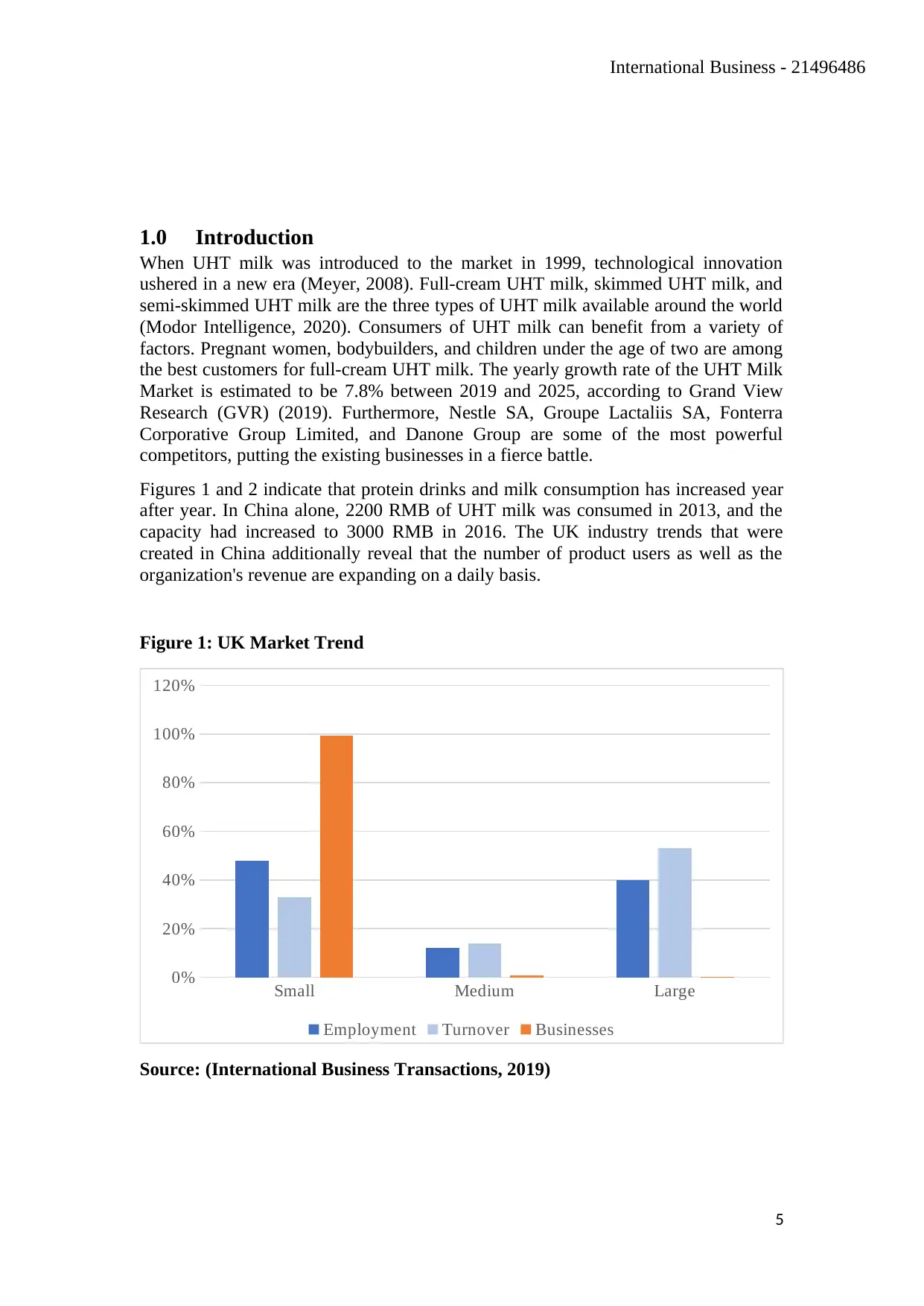
International Business - 21496486
1.0 Introduction
When UHT milk was introduced to the market in 1999, technological innovation
ushered in a new era (Meyer, 2008). Full-cream UHT milk, skimmed UHT milk, and
semi-skimmed UHT milk are the three types of UHT milk available around the world
(Modor Intelligence, 2020). Consumers of UHT milk can benefit from a variety of
factors. Pregnant women, bodybuilders, and children under the age of two are among
the best customers for full-cream UHT milk. The yearly growth rate of the UHT Milk
Market is estimated to be 7.8% between 2019 and 2025, according to Grand View
Research (GVR) (2019). Furthermore, Nestle SA, Groupe Lactaliis SA, Fonterra
Corporative Group Limited, and Danone Group are some of the most powerful
competitors, putting the existing businesses in a fierce battle.
Figures 1 and 2 indicate that protein drinks and milk consumption has increased year
after year. In China alone, 2200 RMB of UHT milk was consumed in 2013, and the
capacity had increased to 3000 RMB in 2016. The UK industry trends that were
created in China additionally reveal that the number of product users as well as the
organization's revenue are expanding on a daily basis.
Figure 1: UK Market Trend
Small Medium Large
0%
20%
40%
60%
80%
100%
120%
Employment Turnover Businesses
Source: (International Business Transactions, 2019)
5
1.0 Introduction
When UHT milk was introduced to the market in 1999, technological innovation
ushered in a new era (Meyer, 2008). Full-cream UHT milk, skimmed UHT milk, and
semi-skimmed UHT milk are the three types of UHT milk available around the world
(Modor Intelligence, 2020). Consumers of UHT milk can benefit from a variety of
factors. Pregnant women, bodybuilders, and children under the age of two are among
the best customers for full-cream UHT milk. The yearly growth rate of the UHT Milk
Market is estimated to be 7.8% between 2019 and 2025, according to Grand View
Research (GVR) (2019). Furthermore, Nestle SA, Groupe Lactaliis SA, Fonterra
Corporative Group Limited, and Danone Group are some of the most powerful
competitors, putting the existing businesses in a fierce battle.
Figures 1 and 2 indicate that protein drinks and milk consumption has increased year
after year. In China alone, 2200 RMB of UHT milk was consumed in 2013, and the
capacity had increased to 3000 RMB in 2016. The UK industry trends that were
created in China additionally reveal that the number of product users as well as the
organization's revenue are expanding on a daily basis.
Figure 1: UK Market Trend
Small Medium Large
0%
20%
40%
60%
80%
100%
120%
Employment Turnover Businesses
Source: (International Business Transactions, 2019)
5
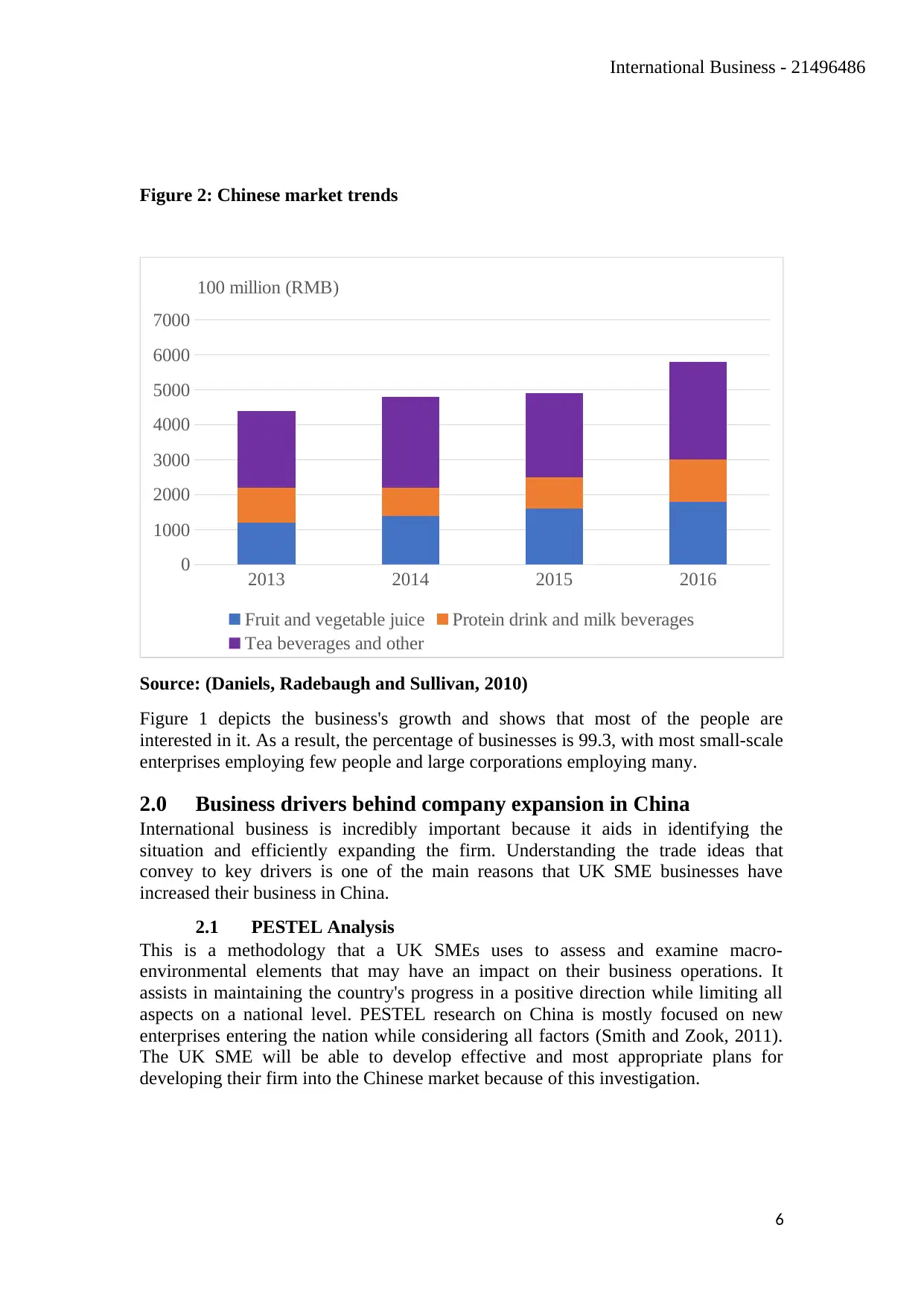
International Business - 21496486
Figure 2: Chinese market trends
2013 2014 2015 2016
0
1000
2000
3000
4000
5000
6000
7000
100 million (RMB)
Fruit and vegetable juice Protein drink and milk beverages
Tea beverages and other
Source: (Daniels, Radebaugh and Sullivan, 2010)
Figure 1 depicts the business's growth and shows that most of the people are
interested in it. As a result, the percentage of businesses is 99.3, with most small-scale
enterprises employing few people and large corporations employing many.
2.0 Business drivers behind company expansion in China
International business is incredibly important because it aids in identifying the
situation and efficiently expanding the firm. Understanding the trade ideas that
convey to key drivers is one of the main reasons that UK SME businesses have
increased their business in China.
2.1 PESTEL Analysis
This is a methodology that a UK SMEs uses to assess and examine macro-
environmental elements that may have an impact on their business operations. It
assists in maintaining the country's progress in a positive direction while limiting all
aspects on a national level. PESTEL research on China is mostly focused on new
enterprises entering the nation while considering all factors (Smith and Zook, 2011).
The UK SME will be able to develop effective and most appropriate plans for
developing their firm into the Chinese market because of this investigation.
6
Figure 2: Chinese market trends
2013 2014 2015 2016
0
1000
2000
3000
4000
5000
6000
7000
100 million (RMB)
Fruit and vegetable juice Protein drink and milk beverages
Tea beverages and other
Source: (Daniels, Radebaugh and Sullivan, 2010)
Figure 1 depicts the business's growth and shows that most of the people are
interested in it. As a result, the percentage of businesses is 99.3, with most small-scale
enterprises employing few people and large corporations employing many.
2.0 Business drivers behind company expansion in China
International business is incredibly important because it aids in identifying the
situation and efficiently expanding the firm. Understanding the trade ideas that
convey to key drivers is one of the main reasons that UK SME businesses have
increased their business in China.
2.1 PESTEL Analysis
This is a methodology that a UK SMEs uses to assess and examine macro-
environmental elements that may have an impact on their business operations. It
assists in maintaining the country's progress in a positive direction while limiting all
aspects on a national level. PESTEL research on China is mostly focused on new
enterprises entering the nation while considering all factors (Smith and Zook, 2011).
The UK SME will be able to develop effective and most appropriate plans for
developing their firm into the Chinese market because of this investigation.
6
⊘ This is a preview!⊘
Do you want full access?
Subscribe today to unlock all pages.

Trusted by 1+ million students worldwide
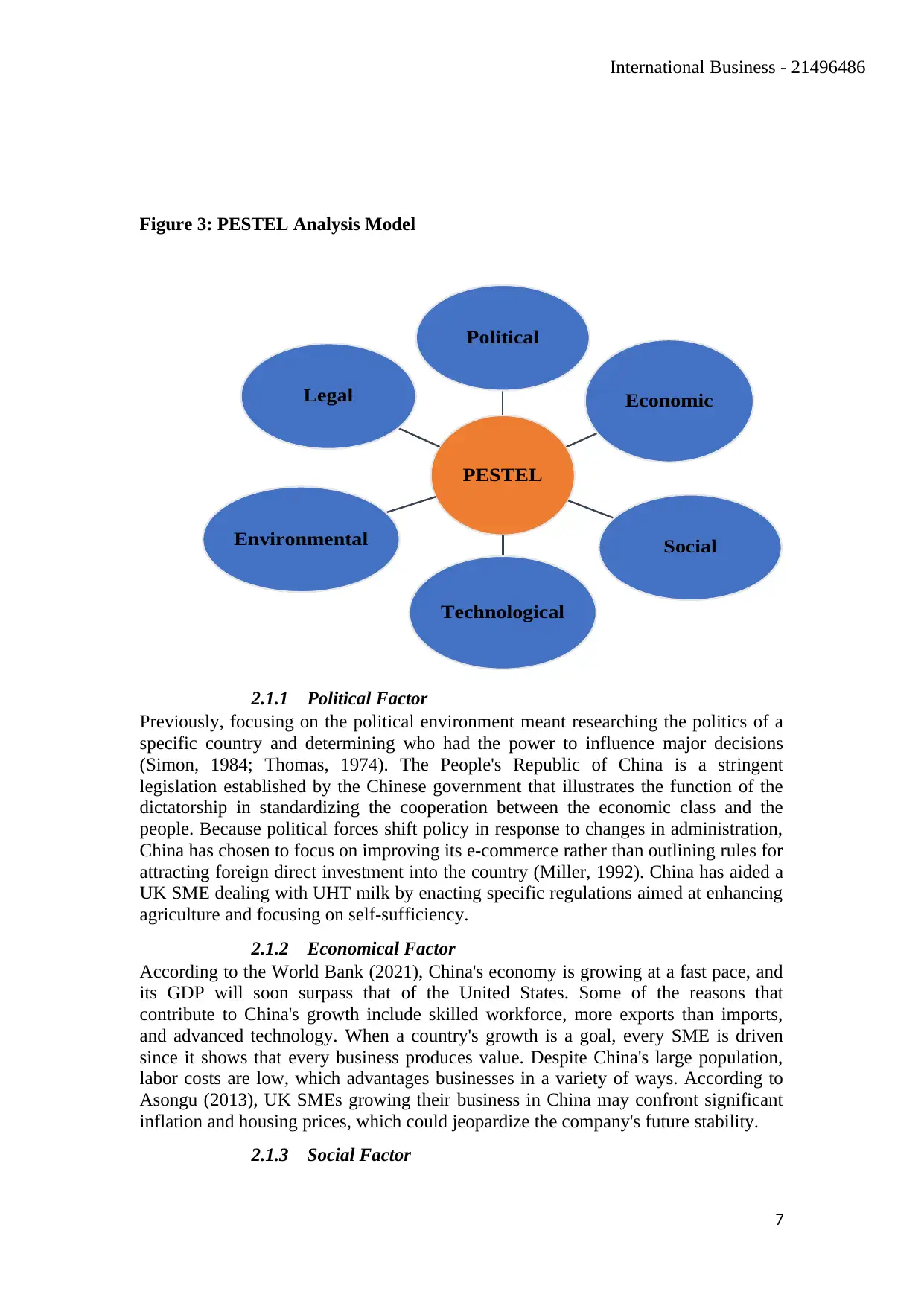
International Business - 21496486
Figure 3: PESTEL Analysis Model
2.1.1 Political Factor
Previously, focusing on the political environment meant researching the politics of a
specific country and determining who had the power to influence major decisions
(Simon, 1984; Thomas, 1974). The People's Republic of China is a stringent
legislation established by the Chinese government that illustrates the function of the
dictatorship in standardizing the cooperation between the economic class and the
people. Because political forces shift policy in response to changes in administration,
China has chosen to focus on improving its e-commerce rather than outlining rules for
attracting foreign direct investment into the country (Miller, 1992). China has aided a
UK SME dealing with UHT milk by enacting specific regulations aimed at enhancing
agriculture and focusing on self-sufficiency.
2.1.2 Economical Factor
According to the World Bank (2021), China's economy is growing at a fast pace, and
its GDP will soon surpass that of the United States. Some of the reasons that
contribute to China's growth include skilled workforce, more exports than imports,
and advanced technology. When a country's growth is a goal, every SME is driven
since it shows that every business produces value. Despite China's large population,
labor costs are low, which advantages businesses in a variety of ways. According to
Asongu (2013), UK SMEs growing their business in China may confront significant
inflation and housing prices, which could jeopardize the company's future stability.
2.1.3 Social Factor
7
PESTEL
Political
Economic
Social
Technological
Environmental
Legal
Figure 3: PESTEL Analysis Model
2.1.1 Political Factor
Previously, focusing on the political environment meant researching the politics of a
specific country and determining who had the power to influence major decisions
(Simon, 1984; Thomas, 1974). The People's Republic of China is a stringent
legislation established by the Chinese government that illustrates the function of the
dictatorship in standardizing the cooperation between the economic class and the
people. Because political forces shift policy in response to changes in administration,
China has chosen to focus on improving its e-commerce rather than outlining rules for
attracting foreign direct investment into the country (Miller, 1992). China has aided a
UK SME dealing with UHT milk by enacting specific regulations aimed at enhancing
agriculture and focusing on self-sufficiency.
2.1.2 Economical Factor
According to the World Bank (2021), China's economy is growing at a fast pace, and
its GDP will soon surpass that of the United States. Some of the reasons that
contribute to China's growth include skilled workforce, more exports than imports,
and advanced technology. When a country's growth is a goal, every SME is driven
since it shows that every business produces value. Despite China's large population,
labor costs are low, which advantages businesses in a variety of ways. According to
Asongu (2013), UK SMEs growing their business in China may confront significant
inflation and housing prices, which could jeopardize the company's future stability.
2.1.3 Social Factor
7
PESTEL
Political
Economic
Social
Technological
Environmental
Legal
Paraphrase This Document
Need a fresh take? Get an instant paraphrase of this document with our AI Paraphraser
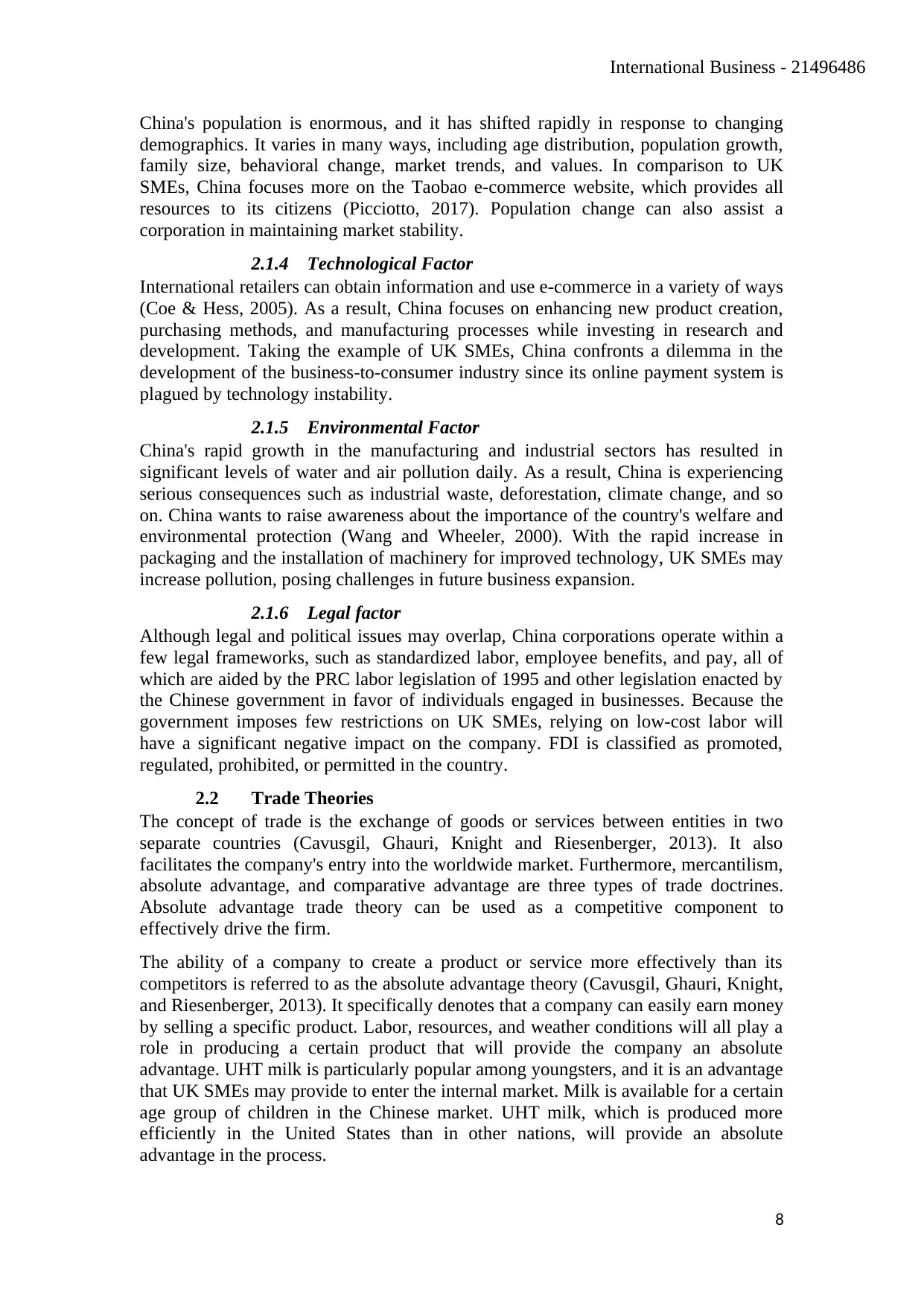
International Business - 21496486
China's population is enormous, and it has shifted rapidly in response to changing
demographics. It varies in many ways, including age distribution, population growth,
family size, behavioral change, market trends, and values. In comparison to UK
SMEs, China focuses more on the Taobao e-commerce website, which provides all
resources to its citizens (Picciotto, 2017). Population change can also assist a
corporation in maintaining market stability.
2.1.4 Technological Factor
International retailers can obtain information and use e-commerce in a variety of ways
(Coe & Hess, 2005). As a result, China focuses on enhancing new product creation,
purchasing methods, and manufacturing processes while investing in research and
development. Taking the example of UK SMEs, China confronts a dilemma in the
development of the business-to-consumer industry since its online payment system is
plagued by technology instability.
2.1.5 Environmental Factor
China's rapid growth in the manufacturing and industrial sectors has resulted in
significant levels of water and air pollution daily. As a result, China is experiencing
serious consequences such as industrial waste, deforestation, climate change, and so
on. China wants to raise awareness about the importance of the country's welfare and
environmental protection (Wang and Wheeler, 2000). With the rapid increase in
packaging and the installation of machinery for improved technology, UK SMEs may
increase pollution, posing challenges in future business expansion.
2.1.6 Legal factor
Although legal and political issues may overlap, China corporations operate within a
few legal frameworks, such as standardized labor, employee benefits, and pay, all of
which are aided by the PRC labor legislation of 1995 and other legislation enacted by
the Chinese government in favor of individuals engaged in businesses. Because the
government imposes few restrictions on UK SMEs, relying on low-cost labor will
have a significant negative impact on the company. FDI is classified as promoted,
regulated, prohibited, or permitted in the country.
2.2 Trade Theories
The concept of trade is the exchange of goods or services between entities in two
separate countries (Cavusgil, Ghauri, Knight and Riesenberger, 2013). It also
facilitates the company's entry into the worldwide market. Furthermore, mercantilism,
absolute advantage, and comparative advantage are three types of trade doctrines.
Absolute advantage trade theory can be used as a competitive component to
effectively drive the firm.
The ability of a company to create a product or service more effectively than its
competitors is referred to as the absolute advantage theory (Cavusgil, Ghauri, Knight,
and Riesenberger, 2013). It specifically denotes that a company can easily earn money
by selling a specific product. Labor, resources, and weather conditions will all play a
role in producing a certain product that will provide the company an absolute
advantage. UHT milk is particularly popular among youngsters, and it is an advantage
that UK SMEs may provide to enter the internal market. Milk is available for a certain
age group of children in the Chinese market. UHT milk, which is produced more
efficiently in the United States than in other nations, will provide an absolute
advantage in the process.
8
China's population is enormous, and it has shifted rapidly in response to changing
demographics. It varies in many ways, including age distribution, population growth,
family size, behavioral change, market trends, and values. In comparison to UK
SMEs, China focuses more on the Taobao e-commerce website, which provides all
resources to its citizens (Picciotto, 2017). Population change can also assist a
corporation in maintaining market stability.
2.1.4 Technological Factor
International retailers can obtain information and use e-commerce in a variety of ways
(Coe & Hess, 2005). As a result, China focuses on enhancing new product creation,
purchasing methods, and manufacturing processes while investing in research and
development. Taking the example of UK SMEs, China confronts a dilemma in the
development of the business-to-consumer industry since its online payment system is
plagued by technology instability.
2.1.5 Environmental Factor
China's rapid growth in the manufacturing and industrial sectors has resulted in
significant levels of water and air pollution daily. As a result, China is experiencing
serious consequences such as industrial waste, deforestation, climate change, and so
on. China wants to raise awareness about the importance of the country's welfare and
environmental protection (Wang and Wheeler, 2000). With the rapid increase in
packaging and the installation of machinery for improved technology, UK SMEs may
increase pollution, posing challenges in future business expansion.
2.1.6 Legal factor
Although legal and political issues may overlap, China corporations operate within a
few legal frameworks, such as standardized labor, employee benefits, and pay, all of
which are aided by the PRC labor legislation of 1995 and other legislation enacted by
the Chinese government in favor of individuals engaged in businesses. Because the
government imposes few restrictions on UK SMEs, relying on low-cost labor will
have a significant negative impact on the company. FDI is classified as promoted,
regulated, prohibited, or permitted in the country.
2.2 Trade Theories
The concept of trade is the exchange of goods or services between entities in two
separate countries (Cavusgil, Ghauri, Knight and Riesenberger, 2013). It also
facilitates the company's entry into the worldwide market. Furthermore, mercantilism,
absolute advantage, and comparative advantage are three types of trade doctrines.
Absolute advantage trade theory can be used as a competitive component to
effectively drive the firm.
The ability of a company to create a product or service more effectively than its
competitors is referred to as the absolute advantage theory (Cavusgil, Ghauri, Knight,
and Riesenberger, 2013). It specifically denotes that a company can easily earn money
by selling a specific product. Labor, resources, and weather conditions will all play a
role in producing a certain product that will provide the company an absolute
advantage. UHT milk is particularly popular among youngsters, and it is an advantage
that UK SMEs may provide to enter the internal market. Milk is available for a certain
age group of children in the Chinese market. UHT milk, which is produced more
efficiently in the United States than in other nations, will provide an absolute
advantage in the process.
8
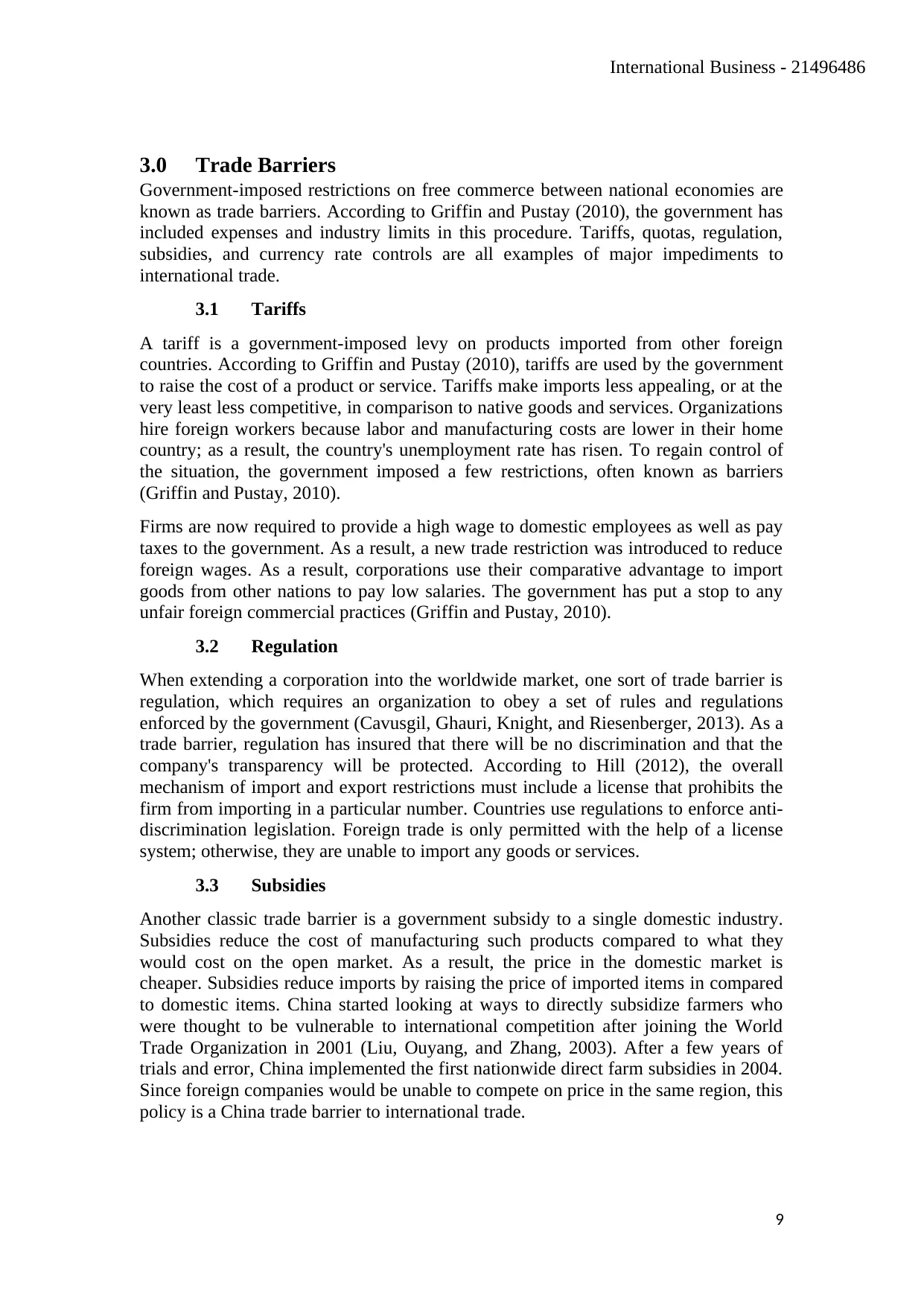
International Business - 21496486
3.0 Trade Barriers
Government-imposed restrictions on free commerce between national economies are
known as trade barriers. According to Griffin and Pustay (2010), the government has
included expenses and industry limits in this procedure. Tariffs, quotas, regulation,
subsidies, and currency rate controls are all examples of major impediments to
international trade.
3.1 Tariffs
A tariff is a government-imposed levy on products imported from other foreign
countries. According to Griffin and Pustay (2010), tariffs are used by the government
to raise the cost of a product or service. Tariffs make imports less appealing, or at the
very least less competitive, in comparison to native goods and services. Organizations
hire foreign workers because labor and manufacturing costs are lower in their home
country; as a result, the country's unemployment rate has risen. To regain control of
the situation, the government imposed a few restrictions, often known as barriers
(Griffin and Pustay, 2010).
Firms are now required to provide a high wage to domestic employees as well as pay
taxes to the government. As a result, a new trade restriction was introduced to reduce
foreign wages. As a result, corporations use their comparative advantage to import
goods from other nations to pay low salaries. The government has put a stop to any
unfair foreign commercial practices (Griffin and Pustay, 2010).
3.2 Regulation
When extending a corporation into the worldwide market, one sort of trade barrier is
regulation, which requires an organization to obey a set of rules and regulations
enforced by the government (Cavusgil, Ghauri, Knight, and Riesenberger, 2013). As a
trade barrier, regulation has insured that there will be no discrimination and that the
company's transparency will be protected. According to Hill (2012), the overall
mechanism of import and export restrictions must include a license that prohibits the
firm from importing in a particular number. Countries use regulations to enforce anti-
discrimination legislation. Foreign trade is only permitted with the help of a license
system; otherwise, they are unable to import any goods or services.
3.3 Subsidies
Another classic trade barrier is a government subsidy to a single domestic industry.
Subsidies reduce the cost of manufacturing such products compared to what they
would cost on the open market. As a result, the price in the domestic market is
cheaper. Subsidies reduce imports by raising the price of imported items in compared
to domestic items. China started looking at ways to directly subsidize farmers who
were thought to be vulnerable to international competition after joining the World
Trade Organization in 2001 (Liu, Ouyang, and Zhang, 2003). After a few years of
trials and error, China implemented the first nationwide direct farm subsidies in 2004.
Since foreign companies would be unable to compete on price in the same region, this
policy is a China trade barrier to international trade.
9
3.0 Trade Barriers
Government-imposed restrictions on free commerce between national economies are
known as trade barriers. According to Griffin and Pustay (2010), the government has
included expenses and industry limits in this procedure. Tariffs, quotas, regulation,
subsidies, and currency rate controls are all examples of major impediments to
international trade.
3.1 Tariffs
A tariff is a government-imposed levy on products imported from other foreign
countries. According to Griffin and Pustay (2010), tariffs are used by the government
to raise the cost of a product or service. Tariffs make imports less appealing, or at the
very least less competitive, in comparison to native goods and services. Organizations
hire foreign workers because labor and manufacturing costs are lower in their home
country; as a result, the country's unemployment rate has risen. To regain control of
the situation, the government imposed a few restrictions, often known as barriers
(Griffin and Pustay, 2010).
Firms are now required to provide a high wage to domestic employees as well as pay
taxes to the government. As a result, a new trade restriction was introduced to reduce
foreign wages. As a result, corporations use their comparative advantage to import
goods from other nations to pay low salaries. The government has put a stop to any
unfair foreign commercial practices (Griffin and Pustay, 2010).
3.2 Regulation
When extending a corporation into the worldwide market, one sort of trade barrier is
regulation, which requires an organization to obey a set of rules and regulations
enforced by the government (Cavusgil, Ghauri, Knight, and Riesenberger, 2013). As a
trade barrier, regulation has insured that there will be no discrimination and that the
company's transparency will be protected. According to Hill (2012), the overall
mechanism of import and export restrictions must include a license that prohibits the
firm from importing in a particular number. Countries use regulations to enforce anti-
discrimination legislation. Foreign trade is only permitted with the help of a license
system; otherwise, they are unable to import any goods or services.
3.3 Subsidies
Another classic trade barrier is a government subsidy to a single domestic industry.
Subsidies reduce the cost of manufacturing such products compared to what they
would cost on the open market. As a result, the price in the domestic market is
cheaper. Subsidies reduce imports by raising the price of imported items in compared
to domestic items. China started looking at ways to directly subsidize farmers who
were thought to be vulnerable to international competition after joining the World
Trade Organization in 2001 (Liu, Ouyang, and Zhang, 2003). After a few years of
trials and error, China implemented the first nationwide direct farm subsidies in 2004.
Since foreign companies would be unable to compete on price in the same region, this
policy is a China trade barrier to international trade.
9
⊘ This is a preview!⊘
Do you want full access?
Subscribe today to unlock all pages.

Trusted by 1+ million students worldwide
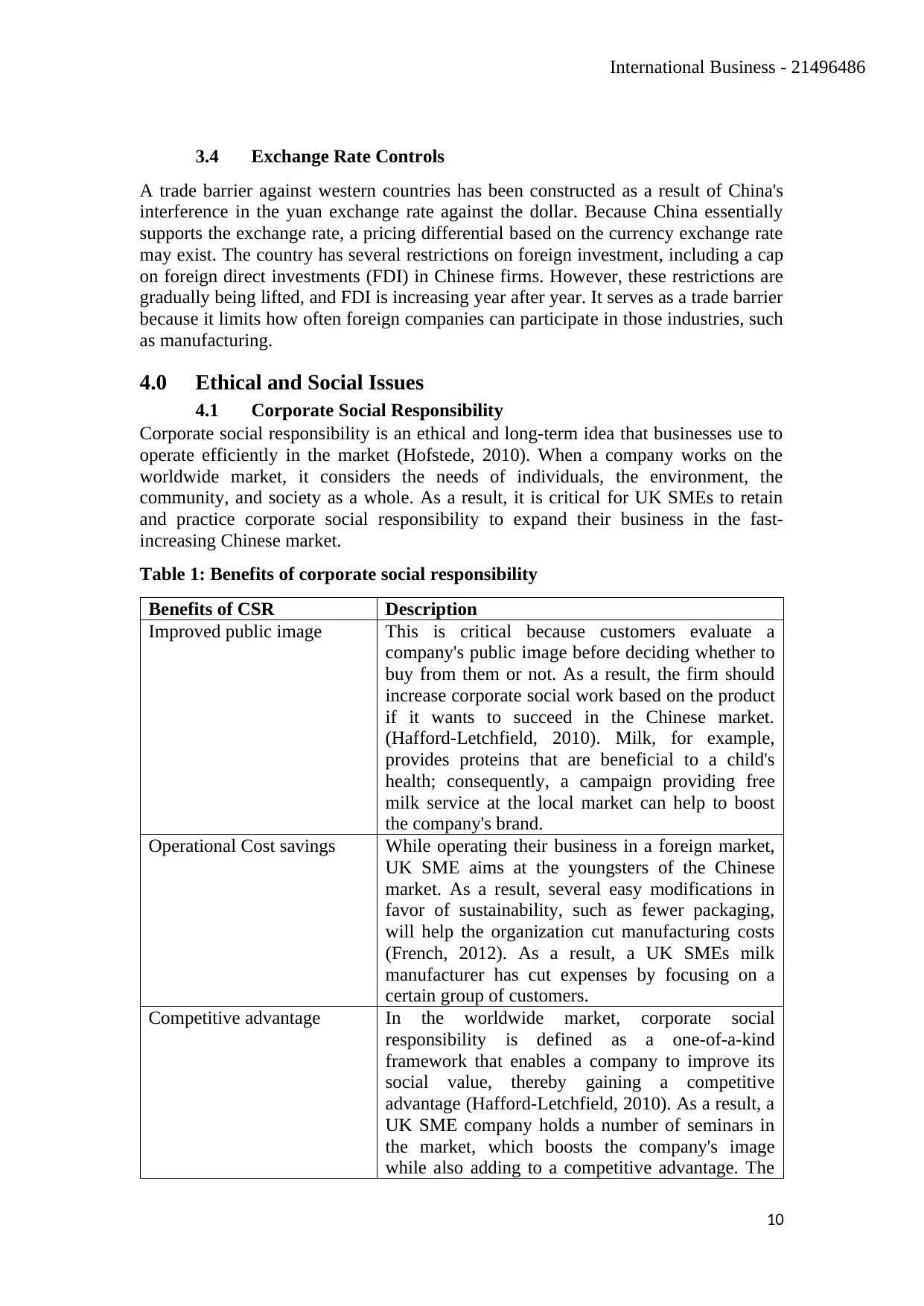
International Business - 21496486
3.4 Exchange Rate Controls
A trade barrier against western countries has been constructed as a result of China's
interference in the yuan exchange rate against the dollar. Because China essentially
supports the exchange rate, a pricing differential based on the currency exchange rate
may exist. The country has several restrictions on foreign investment, including a cap
on foreign direct investments (FDI) in Chinese firms. However, these restrictions are
gradually being lifted, and FDI is increasing year after year. It serves as a trade barrier
because it limits how often foreign companies can participate in those industries, such
as manufacturing.
4.0 Ethical and Social Issues
4.1 Corporate Social Responsibility
Corporate social responsibility is an ethical and long-term idea that businesses use to
operate efficiently in the market (Hofstede, 2010). When a company works on the
worldwide market, it considers the needs of individuals, the environment, the
community, and society as a whole. As a result, it is critical for UK SMEs to retain
and practice corporate social responsibility to expand their business in the fast-
increasing Chinese market.
Table 1: Benefits of corporate social responsibility
Benefits of CSR Description
Improved public image This is critical because customers evaluate a
company's public image before deciding whether to
buy from them or not. As a result, the firm should
increase corporate social work based on the product
if it wants to succeed in the Chinese market.
(Hafford-Letchfield, 2010). Milk, for example,
provides proteins that are beneficial to a child's
health; consequently, a campaign providing free
milk service at the local market can help to boost
the company's brand.
Operational Cost savings While operating their business in a foreign market,
UK SME aims at the youngsters of the Chinese
market. As a result, several easy modifications in
favor of sustainability, such as fewer packaging,
will help the organization cut manufacturing costs
(French, 2012). As a result, a UK SMEs milk
manufacturer has cut expenses by focusing on a
certain group of customers.
Competitive advantage In the worldwide market, corporate social
responsibility is defined as a one-of-a-kind
framework that enables a company to improve its
social value, thereby gaining a competitive
advantage (Hafford-Letchfield, 2010). As a result, a
UK SME company holds a number of seminars in
the market, which boosts the company's image
while also adding to a competitive advantage. The
10
3.4 Exchange Rate Controls
A trade barrier against western countries has been constructed as a result of China's
interference in the yuan exchange rate against the dollar. Because China essentially
supports the exchange rate, a pricing differential based on the currency exchange rate
may exist. The country has several restrictions on foreign investment, including a cap
on foreign direct investments (FDI) in Chinese firms. However, these restrictions are
gradually being lifted, and FDI is increasing year after year. It serves as a trade barrier
because it limits how often foreign companies can participate in those industries, such
as manufacturing.
4.0 Ethical and Social Issues
4.1 Corporate Social Responsibility
Corporate social responsibility is an ethical and long-term idea that businesses use to
operate efficiently in the market (Hofstede, 2010). When a company works on the
worldwide market, it considers the needs of individuals, the environment, the
community, and society as a whole. As a result, it is critical for UK SMEs to retain
and practice corporate social responsibility to expand their business in the fast-
increasing Chinese market.
Table 1: Benefits of corporate social responsibility
Benefits of CSR Description
Improved public image This is critical because customers evaluate a
company's public image before deciding whether to
buy from them or not. As a result, the firm should
increase corporate social work based on the product
if it wants to succeed in the Chinese market.
(Hafford-Letchfield, 2010). Milk, for example,
provides proteins that are beneficial to a child's
health; consequently, a campaign providing free
milk service at the local market can help to boost
the company's brand.
Operational Cost savings While operating their business in a foreign market,
UK SME aims at the youngsters of the Chinese
market. As a result, several easy modifications in
favor of sustainability, such as fewer packaging,
will help the organization cut manufacturing costs
(French, 2012). As a result, a UK SMEs milk
manufacturer has cut expenses by focusing on a
certain group of customers.
Competitive advantage In the worldwide market, corporate social
responsibility is defined as a one-of-a-kind
framework that enables a company to improve its
social value, thereby gaining a competitive
advantage (Hafford-Letchfield, 2010). As a result, a
UK SME company holds a number of seminars in
the market, which boosts the company's image
while also adding to a competitive advantage. The
10
Paraphrase This Document
Need a fresh take? Get an instant paraphrase of this document with our AI Paraphraser
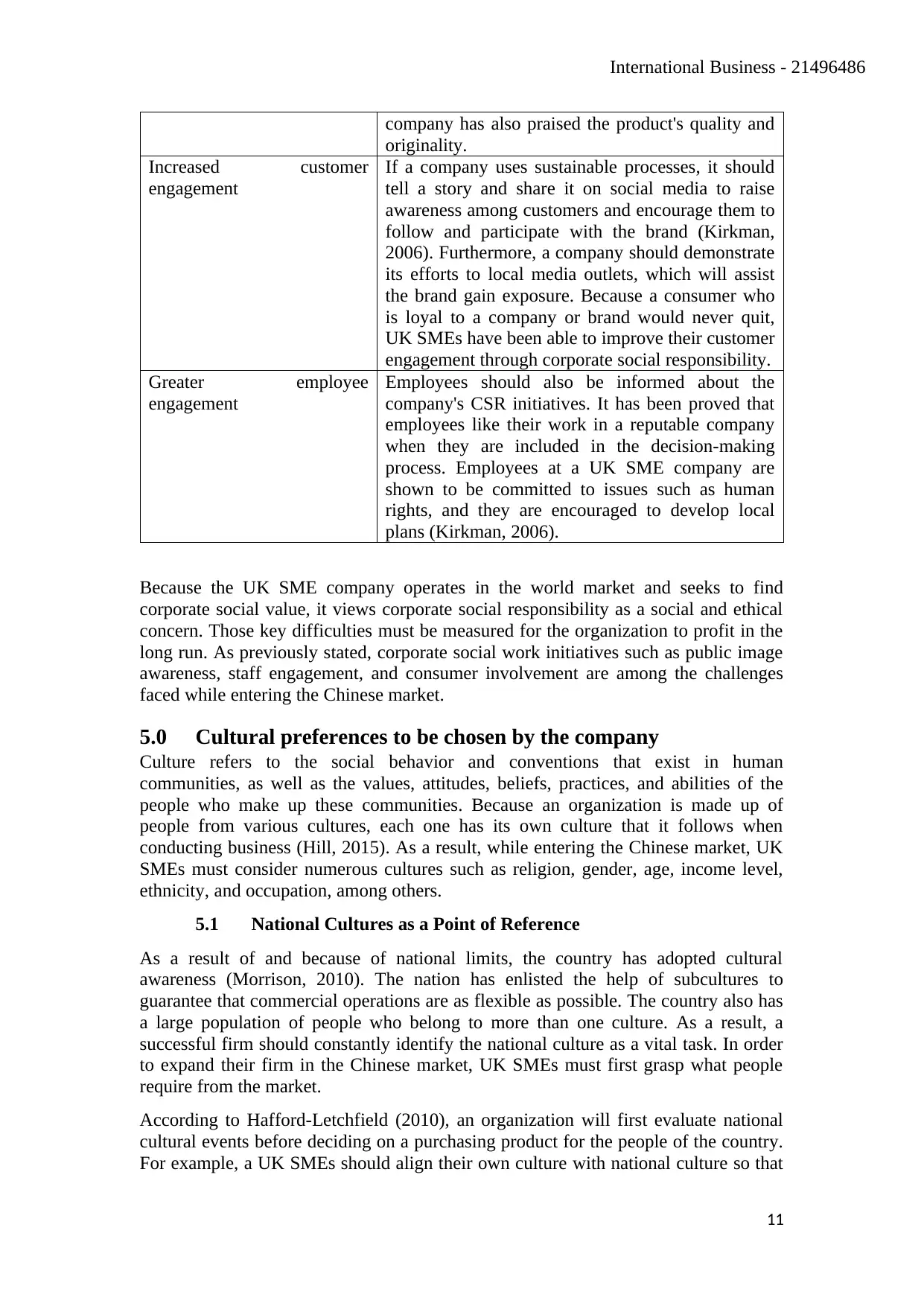
International Business - 21496486
company has also praised the product's quality and
originality.
Increased customer
engagement
If a company uses sustainable processes, it should
tell a story and share it on social media to raise
awareness among customers and encourage them to
follow and participate with the brand (Kirkman,
2006). Furthermore, a company should demonstrate
its efforts to local media outlets, which will assist
the brand gain exposure. Because a consumer who
is loyal to a company or brand would never quit,
UK SMEs have been able to improve their customer
engagement through corporate social responsibility.
Greater employee
engagement
Employees should also be informed about the
company's CSR initiatives. It has been proved that
employees like their work in a reputable company
when they are included in the decision-making
process. Employees at a UK SME company are
shown to be committed to issues such as human
rights, and they are encouraged to develop local
plans (Kirkman, 2006).
Because the UK SME company operates in the world market and seeks to find
corporate social value, it views corporate social responsibility as a social and ethical
concern. Those key difficulties must be measured for the organization to profit in the
long run. As previously stated, corporate social work initiatives such as public image
awareness, staff engagement, and consumer involvement are among the challenges
faced while entering the Chinese market.
5.0 Cultural preferences to be chosen by the company
Culture refers to the social behavior and conventions that exist in human
communities, as well as the values, attitudes, beliefs, practices, and abilities of the
people who make up these communities. Because an organization is made up of
people from various cultures, each one has its own culture that it follows when
conducting business (Hill, 2015). As a result, while entering the Chinese market, UK
SMEs must consider numerous cultures such as religion, gender, age, income level,
ethnicity, and occupation, among others.
5.1 National Cultures as a Point of Reference
As a result of and because of national limits, the country has adopted cultural
awareness (Morrison, 2010). The nation has enlisted the help of subcultures to
guarantee that commercial operations are as flexible as possible. The country also has
a large population of people who belong to more than one culture. As a result, a
successful firm should constantly identify the national culture as a vital task. In order
to expand their firm in the Chinese market, UK SMEs must first grasp what people
require from the market.
According to Hafford-Letchfield (2010), an organization will first evaluate national
cultural events before deciding on a purchasing product for the people of the country.
For example, a UK SMEs should align their own culture with national culture so that
11
company has also praised the product's quality and
originality.
Increased customer
engagement
If a company uses sustainable processes, it should
tell a story and share it on social media to raise
awareness among customers and encourage them to
follow and participate with the brand (Kirkman,
2006). Furthermore, a company should demonstrate
its efforts to local media outlets, which will assist
the brand gain exposure. Because a consumer who
is loyal to a company or brand would never quit,
UK SMEs have been able to improve their customer
engagement through corporate social responsibility.
Greater employee
engagement
Employees should also be informed about the
company's CSR initiatives. It has been proved that
employees like their work in a reputable company
when they are included in the decision-making
process. Employees at a UK SME company are
shown to be committed to issues such as human
rights, and they are encouraged to develop local
plans (Kirkman, 2006).
Because the UK SME company operates in the world market and seeks to find
corporate social value, it views corporate social responsibility as a social and ethical
concern. Those key difficulties must be measured for the organization to profit in the
long run. As previously stated, corporate social work initiatives such as public image
awareness, staff engagement, and consumer involvement are among the challenges
faced while entering the Chinese market.
5.0 Cultural preferences to be chosen by the company
Culture refers to the social behavior and conventions that exist in human
communities, as well as the values, attitudes, beliefs, practices, and abilities of the
people who make up these communities. Because an organization is made up of
people from various cultures, each one has its own culture that it follows when
conducting business (Hill, 2015). As a result, while entering the Chinese market, UK
SMEs must consider numerous cultures such as religion, gender, age, income level,
ethnicity, and occupation, among others.
5.1 National Cultures as a Point of Reference
As a result of and because of national limits, the country has adopted cultural
awareness (Morrison, 2010). The nation has enlisted the help of subcultures to
guarantee that commercial operations are as flexible as possible. The country also has
a large population of people who belong to more than one culture. As a result, a
successful firm should constantly identify the national culture as a vital task. In order
to expand their firm in the Chinese market, UK SMEs must first grasp what people
require from the market.
According to Hafford-Letchfield (2010), an organization will first evaluate national
cultural events before deciding on a purchasing product for the people of the country.
For example, a UK SMEs should align their own culture with national culture so that
11
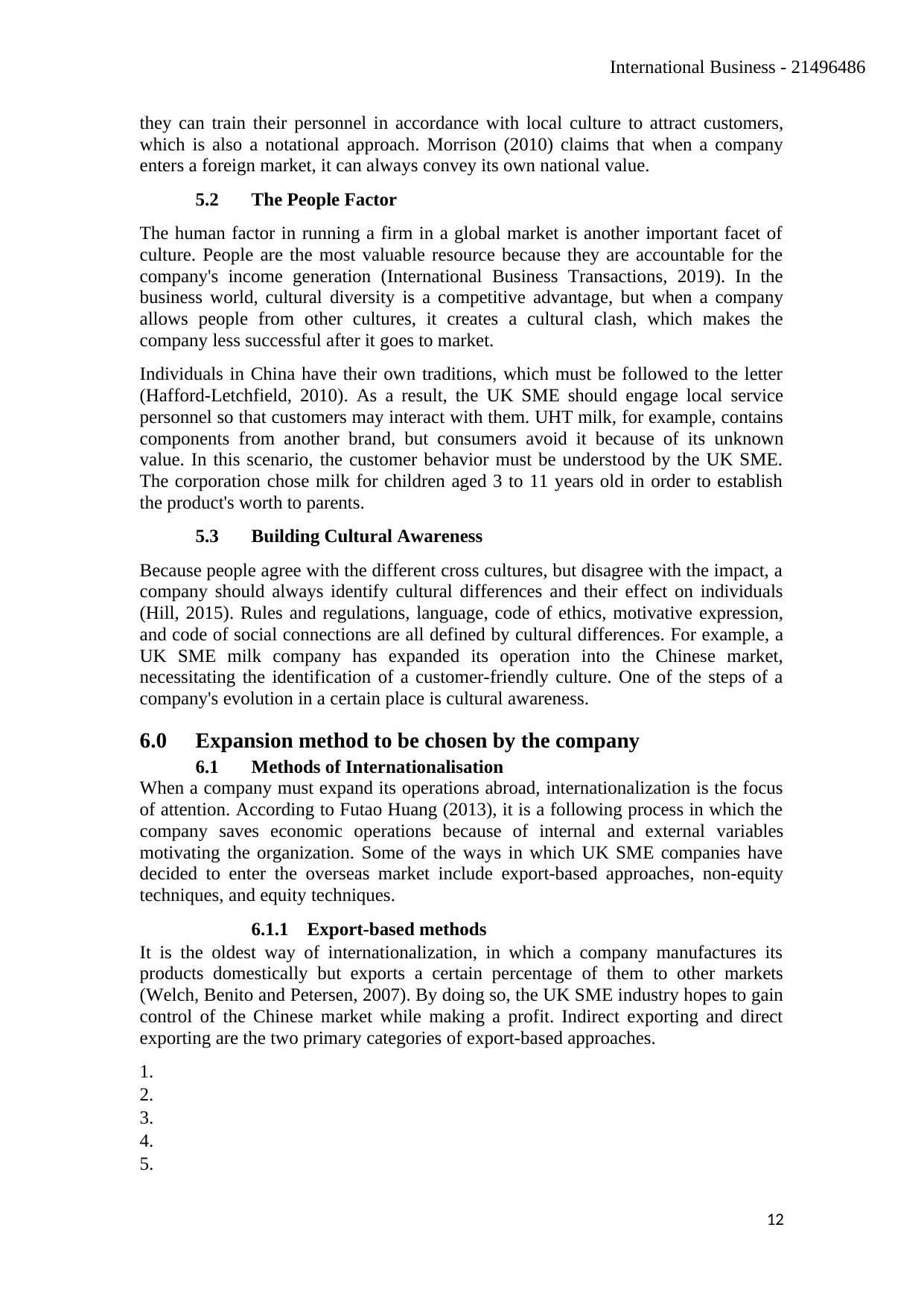
International Business - 21496486
they can train their personnel in accordance with local culture to attract customers,
which is also a notational approach. Morrison (2010) claims that when a company
enters a foreign market, it can always convey its own national value.
5.2 The People Factor
The human factor in running a firm in a global market is another important facet of
culture. People are the most valuable resource because they are accountable for the
company's income generation (International Business Transactions, 2019). In the
business world, cultural diversity is a competitive advantage, but when a company
allows people from other cultures, it creates a cultural clash, which makes the
company less successful after it goes to market.
Individuals in China have their own traditions, which must be followed to the letter
(Hafford-Letchfield, 2010). As a result, the UK SME should engage local service
personnel so that customers may interact with them. UHT milk, for example, contains
components from another brand, but consumers avoid it because of its unknown
value. In this scenario, the customer behavior must be understood by the UK SME.
The corporation chose milk for children aged 3 to 11 years old in order to establish
the product's worth to parents.
5.3 Building Cultural Awareness
Because people agree with the different cross cultures, but disagree with the impact, a
company should always identify cultural differences and their effect on individuals
(Hill, 2015). Rules and regulations, language, code of ethics, motivative expression,
and code of social connections are all defined by cultural differences. For example, a
UK SME milk company has expanded its operation into the Chinese market,
necessitating the identification of a customer-friendly culture. One of the steps of a
company's evolution in a certain place is cultural awareness.
6.0 Expansion method to be chosen by the company
6.1 Methods of Internationalisation
When a company must expand its operations abroad, internationalization is the focus
of attention. According to Futao Huang (2013), it is a following process in which the
company saves economic operations because of internal and external variables
motivating the organization. Some of the ways in which UK SME companies have
decided to enter the overseas market include export-based approaches, non-equity
techniques, and equity techniques.
6.1.1 Export-based methods
It is the oldest way of internationalization, in which a company manufactures its
products domestically but exports a certain percentage of them to other markets
(Welch, Benito and Petersen, 2007). By doing so, the UK SME industry hopes to gain
control of the Chinese market while making a profit. Indirect exporting and direct
exporting are the two primary categories of export-based approaches.
1.
2.
3.
4.
5.
12
they can train their personnel in accordance with local culture to attract customers,
which is also a notational approach. Morrison (2010) claims that when a company
enters a foreign market, it can always convey its own national value.
5.2 The People Factor
The human factor in running a firm in a global market is another important facet of
culture. People are the most valuable resource because they are accountable for the
company's income generation (International Business Transactions, 2019). In the
business world, cultural diversity is a competitive advantage, but when a company
allows people from other cultures, it creates a cultural clash, which makes the
company less successful after it goes to market.
Individuals in China have their own traditions, which must be followed to the letter
(Hafford-Letchfield, 2010). As a result, the UK SME should engage local service
personnel so that customers may interact with them. UHT milk, for example, contains
components from another brand, but consumers avoid it because of its unknown
value. In this scenario, the customer behavior must be understood by the UK SME.
The corporation chose milk for children aged 3 to 11 years old in order to establish
the product's worth to parents.
5.3 Building Cultural Awareness
Because people agree with the different cross cultures, but disagree with the impact, a
company should always identify cultural differences and their effect on individuals
(Hill, 2015). Rules and regulations, language, code of ethics, motivative expression,
and code of social connections are all defined by cultural differences. For example, a
UK SME milk company has expanded its operation into the Chinese market,
necessitating the identification of a customer-friendly culture. One of the steps of a
company's evolution in a certain place is cultural awareness.
6.0 Expansion method to be chosen by the company
6.1 Methods of Internationalisation
When a company must expand its operations abroad, internationalization is the focus
of attention. According to Futao Huang (2013), it is a following process in which the
company saves economic operations because of internal and external variables
motivating the organization. Some of the ways in which UK SME companies have
decided to enter the overseas market include export-based approaches, non-equity
techniques, and equity techniques.
6.1.1 Export-based methods
It is the oldest way of internationalization, in which a company manufactures its
products domestically but exports a certain percentage of them to other markets
(Welch, Benito and Petersen, 2007). By doing so, the UK SME industry hopes to gain
control of the Chinese market while making a profit. Indirect exporting and direct
exporting are the two primary categories of export-based approaches.
1.
2.
3.
4.
5.
12
⊘ This is a preview!⊘
Do you want full access?
Subscribe today to unlock all pages.

Trusted by 1+ million students worldwide
1 out of 18
Related Documents
Your All-in-One AI-Powered Toolkit for Academic Success.
+13062052269
info@desklib.com
Available 24*7 on WhatsApp / Email
![[object Object]](/_next/static/media/star-bottom.7253800d.svg)
Unlock your academic potential
Copyright © 2020–2025 A2Z Services. All Rights Reserved. Developed and managed by ZUCOL.





